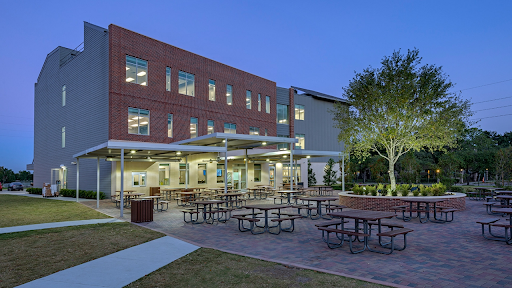The Benefits of On-Campus Learning

A photo of The Village High School patio where on-campus learners eat lunch.
On Tuesday, November 3, 2020, The Village High School was about to begin campus and online classes. Students who have chosen to attend campus classes must awake earlier and endure the chilling cold that awaits them outside their homes. On the other hand, virtual learners may sleep in later and learn at the comfort and ease of their homes. However, it is imperative that we answer the question, what are the benefits of campus learning?
There is a massive contrast in the environment between virtual and in-person learning. Campus learning has kept The Village School’s community spirit somewhat alive. In addition, despite the limitations on Zoom, the platform has connected hundreds of people at this time.
“Campus learning provides a much more collaborative and engaging learning environment by providing hands-on experiences,” said college counselor Maria Correa Rodriguez. “Zoom limits the level of personal interaction necessary for experiential learning, but has been the sole medium of virtual connectivity.”
Another benefit of in-person learning is its ease of communication with peers and the establishment of relationships with teachers. Collaboration, group projects, and student-teacher connectivity is a massive advantage.
“I like campus learning because campus learning helps students interact with each other and with the teacher,” said sophomore Haun Dang, an on-campus learner. “In some classes, campus learning is very effective due to the fact that it is easier and more comfortable for students to communicate with each other for group projects. I dislike Zoom learning because it is harder for students to interact with each other. Zoom learning doesn’t give students the feeling of school and it could distract the students a lot.”
Others also prefer in-person learning because they feel they receive more help. With easier access and more available, face-to-face communication with teachers, students are able to thrive with more support.
“The teacher is closer to students and can help them more,” said junior Christopher Constantine, an in-person school attendee at The Village High School. “I do not like Zoom learning because I feel like it doesn’t not engage enough with my learning.”
Concentration in on-campus learning is also easier to maintain. Moving around classes keeps blood flowing and enthusiasm conserved. There are an array of ways students can distract themselves in virtual school. In a classroom setting, in front of a teacher, these distractions are minimized.
“I don’t like Zoom learning because I find it harder to concentrate,” said Constantine. “I get distracted easily.”
Along with concentration, the difference between the two types of schooling is also about learning environments.
“Zoom learning doesn’t give students the feeling of school,” said Dang.
From the top, virtual school seems like the best, most convenient form of learning. However, on-campus school objectively has many benefits that cannot be overlooked. It is Taylors the needs of certain students that have issues learning online. Ultimately, education in these times is about catering to the comfort of students and providing them with as many opportunities and options as possible, while still prioritizing safety.





